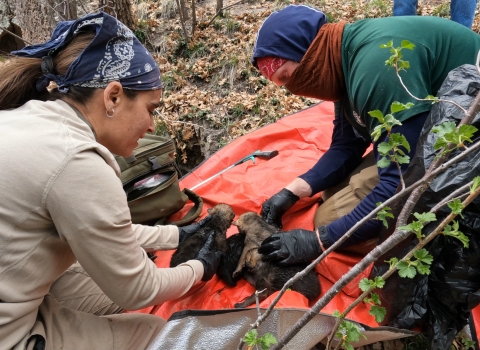BISMARCK, N.D. –The piping plover, a small, sparrow-sized migratory shorebird known for its melodic mating call, may benefit from increased conservation activities, thanks to a new recovery plan released today by the U.S. Fish and Wildlife Service (Service).
This “Draft Revised Recovery Plan” is specific to the Northern Great Plains (NGP) piping plover population, which is currently listed as threatened under the Endangered Species Act (ESA).
“The goal of this plan is to recover the Northern Great Plains population of piping plover and return this species to state management,” said Noreen Walsh, Regional Director for the Service in the Mountain-Prairie Region. “Using the new information we have learned about this species, and by working collaboratively with our partners, we believe we can make that goal a reality.”
Recovery plans consolidate the best available scientific information on listed species and make recommendations on actions needed to achieve recovery. They guide conservation and habitat management activities to help listed species rebound to the point they no longer need the protection of the Endangered Species Act.
The Northern Great Plains population breeds along shorelines and islands of rivers and reservoirs in Montana, North Dakota, South Dakota, and Nebraska in the U.S., as well as on alkaline (salty) lakes along the Missouri Plateau, which extends into Canada. There are also small numbers breeding in Colorado and Minnesota and occasionally in Iowa and Kansas.
In the winter, the NGP population intermingles with two other piping plover populations that breed in the Great Lakes and along the Atlantic Coast. Piping plovers winter along the U.S. Atlantic and Gulf Coasts from North Carolina to Texas and into Mexico, the Bahamas, and West Indies.
Habitat loss and degradation, primarily due to damming and water withdrawals, are the primary threats to the NGP population on its breeding range.
Loss of suitable habitat due to development, human disturbance, predation, and sea-level rise are the primary threats to the NGP population on its wintering grounds.
The draft Revised Recovery Plan identifies actions designed to address these threats and recover the species, with a focus on ecosystem restoration, which will also benefit a variety of other species. The recovery approach proposed in the plan also includes a variety of benefits to people, including flood control, improved water quality, reduced runoff, and better planning for development projects.
To be considered for ESA delisting, wildlife managers will need to ensure that populations are stable or increasing over a 10-year average with enough habitat to keep the birds abundant and well distributed across their range. In addition, agreements must be in place to provide long-term conservation and management for essential breeding and wintering grounds.
The Northern Great Plains Piping Plover Recovery Team authored the draft Revised Recovery Plan. This team is a collaborative effort comprised of experts from the U.S. Fish and Wildlife Service; Environment Canada; Virginia Polytechnic Institute and State University; South Dakota Game, Fish and Parks; Montana Fish, Wildlife and Parks; North Dakota Game and Fish; Nebraska Game and Parks Commission; U.S. Geological Survey; and the U.S. Army Corps of Engineers.
Today’s announcement opens a 60 day comment period, which ends on May 16, 2016.
Comments may be emailed to: pipingplovercomments@fws.gov or sent by mail to: Attn: Kirsten Brennan, U.S. Fish and Wildlife Service, 8315 Highway 8, Kenmare, North Dakota 58746.
Restoring an endangered or threatened animal or plant to the point where it is again a secure, self-sustaining member of its ecosystem is a primary goal of the Service’s endangered species program. To help guide the recovery effort, the Service prepares recovery plans for the federally listed species where a plan will promote the conservation of the species. Recovery plans describe site-specific actions necessary for the conservation of the species; establish objective, measurable criteria which, when met, would result in a determination that the species no longer needs the protection of the Act; and provide estimates of the time and cost for implementing the needed recovery measures.
The mission of the U.S. Fish and Wildlife Service is working with others to conserve, protect, and enhance fish, wildlife, plants, and their habitats for the continuing benefit of the American people. We are both a leader and trusted partner in fish and wildlife conservation, known for our scientific excellence, stewardship of lands and natural resources, dedicated professionals, and commitment to public service.
Connect with our Facebook page at http://www.facebook.com/USFWSMountainPrairie, follow our tweets at http://twitter.com/USFWSMtnPrairie, watch our YouTube Channel at http://www.youtube.com/usfws and download photos from our Flickr page at http://www.flickr.com/photos/usfwsmtnprairie/

